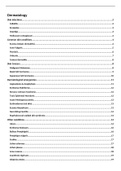Dermatology
Skin infections...........................................................................................................................................2
Cellulitis................................................................................................................................................................2
Erysipelas..............................................................................................................................................................3
Impetigo................................................................................................................................................................3
Molluscum contagiosum.......................................................................................................................................4
Common skin conditions...........................................................................................................................4
Eczema (Atopic dermatitis)....................................................................................................................................4
Acne Vulgaris.........................................................................................................................................................5
Psoriasis................................................................................................................................................................6
Urticaria................................................................................................................................................................7
Contact dermatitis.................................................................................................................................................8
Skin Cancers..............................................................................................................................................8
Malignant Melanoma............................................................................................................................................8
Basal Cell Carcinoma.............................................................................................................................................9
Squamous Cell Carcinoma...................................................................................................................................10
Dermatological emergencies...................................................................................................................11
Angioedema & Anaphylaxis.................................................................................................................................11
Erythema Multiforme..........................................................................................................................................12
Stevens–Johnson Syndrome................................................................................................................................12
Toxic Epidermal Necrolysis..................................................................................................................................12
Acute Meningococcaemia...................................................................................................................................13
Erythroderma (red skin)......................................................................................................................................13
Eczema Herpeticum.............................................................................................................................................13
Necrotizing Fasciitis.............................................................................................................................................14
Staphylococcal scalded skin syndrome................................................................................................................14
Other conditions.....................................................................................................................................14
Ulcers..................................................................................................................................................................14
Erythema Nodosum.............................................................................................................................................16
Bullous Pemphigoid.............................................................................................................................................16
Pemphigus vulgaris..............................................................................................................................................17
Scabies................................................................................................................................................................17
Lichen sclerosus...................................................................................................................................................17
Lichen planus.......................................................................................................................................................18
Acne rosacea.......................................................................................................................................................18
Acanthosis nigricans............................................................................................................................................19
Alopecia areata...................................................................................................................................................19
, Cherry haemangiomas.........................................................................................................................................19
Erythrasma..........................................................................................................................................................19
Granuloma annulare...........................................................................................................................................19
Hereditary haemorrhagic telangiectasia..............................................................................................................20
Hidradenitis suppurativa.....................................................................................................................................20
Keloid scar...........................................................................................................................................................21
Keratoacanthoma................................................................................................................................................22
Leukoplakia.........................................................................................................................................................22
Lipoma................................................................................................................................................................23
Pellagra...............................................................................................................................................................23
Pityriasis rosea....................................................................................................................................................23
Superficial fungal infections....................................................................................................................23
Tinea – Ringworm................................................................................................................................................23
Pityriasis/ tinea versicolor...................................................................................................................................24
Candidiasis (thrush).............................................................................................................................................24
Burns......................................................................................................................................................24
Skin disorders associated with pregnancy...............................................................................................27
Physiological skin changes in pregnancy..............................................................................................................27
Polymorphic eruption of pregnancy....................................................................................................................27
Atopic eruption of pregnancy..............................................................................................................................27
Pemphigoid gestationis.......................................................................................................................................27
Cholestatic pruritis..............................................................................................................................................28
Birthmarks..............................................................................................................................................28
Port wine stains...................................................................................................................................................28
Salmon patches...................................................................................................................................................28
Presentations..........................................................................................................................................28
Hirsutism.............................................................................................................................................................28
Hyperhidrosis......................................................................................................................................................29
Pruritis.................................................................................................................................................................29
Skin infections
Cellulitis
Overview: spreading bacterial infection of the
skin, involving the lower half of the dermis and
subcutaneous fat.
Risk factors: immunosuppression, lymphoedema,
obese/ overweight, illicit injectable drugs, minor
skin injury, hx of cellulitis
Causes: Streptococcus pyogenes, Staphylococcus
aureus
, Presentation: erythema that expands (not well defined), swelling, tenderness, warmth,
pain, fever, systemically unwell (fever, rigors). Most common in lower limbs (shins).
Classification: ‘ERON classification’ of severity
i. I – not systemic Sx, person has no uncontrolled comorbidities
ii. II – systemically unwell, or systemically well with co-morbidity (PAD, morbid obesity)
iii. III – significant systemic illness (acute confusion, tachycardia, hypotension etc),
unstable comorbidities, or limb-threatening infection due to vascular compromise
iv. IV – sepsis or necrotizing fasciitis (life-threatening)
Investigations: swab for culture, skin biopsy (if ?diagnosis), USS (to distinguish non-purulent
cellulitis, from cellulitis with abscess). WCC, ESR, CRP (inflammation)
Management:
i. 1° care: high dose oral abx – flucloxacillin 500mg QDS for 7 days (+benzylpenicillin in
rapid deterioration). Erythromycin in pregnancy, clarithromycin or doxycycline in
penicillin allergy. Drink lots of fluids, rest, elevation, sterile dressings, simple
analgesia.
ii. 2° care: urgent transfer to hospital if stage III/IV, rapidly deteriorating cellulitis, <1
yrs old or frail, immunocompromised, significant lymphodema, facial cellulitis or
periorbital cellulitis and IV abx – Co-amoxiclav/ ceftriaxone/ clindamycin/
vancomycin.
Complications: local necrosis, chronic limb swelling, septicaemia
Erysipelas
Overview: superficial form of cellulitis, involving the
upper half of dermis
Risk factors: lymphoedema, minor skin injury,
immunosuppression
Causes: Streptococcus pyogenes, Staphylococcus
aureus, fungal infection
Presentation: mainly affects lower legs, same
symptoms as cellulitis, but border of swelling is
clearer (skin is raised).
Management: cold packs, analgesia, elevation of
affected limb, wound care, oral/ IV abx e.g. penicillin,
or flucloxacillin 500mg QDS for 10-14 days (erythromycin in allergy)
Complications: necrosis, abscess, sepsis, thrombophlebitis
Impetigo
Overview: infection of the epidermis. 70% ‘non-bullous’, 30% ‘bullous’ (fluid filled lesions
>5mm diameter). Transmission = close contact with infected person/ object (very
contagious). Incubation 4-10 days. It can be a primary infection, or a complication of an
existing skin condition e.g. eczema, scabies or insect bites.
Risk factors: poor hygiene, existing skin
conditions (eczema), cracked skin
Causes: Staphylococcus aureus (toxins produced
cause loss of cell adhesion in superficial dermis,
can lead to bullae), Streptococcus pyogenes
Presentation: lesions tend to appear on face,
‘golden’/crusted/red sores (tiny pustules /
vesicles) around the nose and mouth that quickly
rupture, ooze for a few days, then form a crust
(serum). Can be itchy or painful. Fever,
lymphadenopathy.
, Investigations: clinical diagnosis, swabs for MC&S
Management: reassure that usually heals completely without scarring, advice on good
hygiene to prevent spread to other areas (avoid scratching, wash hands after touching), stay
off work/ school.
i. Topical – topical fusidic acid, topical retapamulin 2nd line, topical mupirocin for
MRSA
ii. Systemic – oral flucloxacillin for 7d (if more widespread or bullous), erythromycin if
penicillin-allergic
iii. Children should be excluded from school until lesions are crusted/healed, or 48
hours after starting Abx treatment
Complications: cellulitis, acute GN in strep impetigo, sepsis, lymphangitis (strep),
staphylococcal scolded skin.
Molluscum contagiosum
Common skin infection caused by molluscum contagiosum virus.
Transmission via close personal contact, or indirectly via fomites
(contaminated surfaces e.g. shared towels and flannels). Most cases
occur in children aged 1-4, especially children with atopic eczema.
Presentation = pink/pearly white papules with central umbilication,
which can be up to 5mm. Lesions appear in clusters anywhere on the body except the palms of the hands
and soles of the feet. In kids, lesions are typically on trunk and in flexures.
Management:
Conservative
o Reassure that it is a self-limiting condition, that spontaneously resolves within 18 months
o Lesions are contagious so avoid sharing towels, clothing, and baths with uninfected people
o Encourage not to scratch the lesions
o Exclusion from school/swimming/gym is not necessary
Treatment isn’t usually recommended, but if they are troublesome then:
o Try squeezing the lesions with fingernails or piercing them after a bath. Only try this on a fre
lesions at one time
o Cryotherapy in older children or adults
o If itching is problematic, prescribe an emollient and a mild topical corticosteroid e.g.
hydrocortisone 1%
o If the skin looks infected the prescribe a topical Abx e.g. fusidic acid 2%
Referral if
o HIV positive with extensive lesions – need urgent referral to HIV specialist
o People with eyelid-margin or ocular lesions and associated red eye – need urgent referral to
ophthalmologist
o Adults with anogenital lesions should be referred to GUM for screening for other STIs
Common skin conditions
Eczema (Atopic dermatitis)
Overview: eczema is a condition where patches of skin
become inflamed, pruritic, red, and cracked. There are
different stages and types of eczema, the most common
being ‘atopic eczema’. Atopic eczema is a chronic, itchy,
inflammatory skin condition presenting most frequently
in childhood. Onset at age 3-6 months. Expected to clear
in 65% of children by 7y, 74% by 16y.




